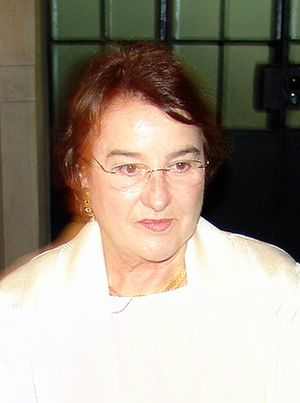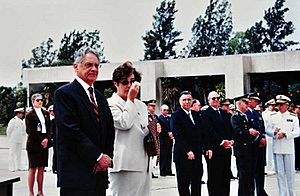Ruth Cardoso facts for kids
Quick facts for kids
Ruth Cardoso
|
|
|---|---|

Cardoso in 2006
|
|
| First Lady of Brazil | |
| In role January 1, 1995 – December 31, 2002 |
|
| President | Fernando Henrique Cardoso |
| Preceded by | Rosane Collor |
| Succeeded by | Marisa Letícia Lula da Silva |
| Personal details | |
| Born |
Ruth Vilaça Correia Leite
September 19, 1930 Araraquara, São Paulo, Brazil |
| Died | June 24, 2008 (aged 77) São Paulo, Brazil |
| Cause of death | Cardiac arrest |
| Spouse | |
| Children | 3 |
| Occupation | Anthropologist |
Ruth Vilaça Correia Leite Cardoso (born September 19, 1930 – died June 24, 2008) was an important Brazilian anthropologist. An anthropologist is a scientist who studies human societies and cultures.
She was also the wife of Fernando Henrique Cardoso, who was the 34th President of Brazil. This made her the First Lady of Brazil from January 1, 1995, to December 31, 2002. Ruth Cardoso earned her Ph.D. in anthropology from the University of São Paulo.
Contents
Ruth Cardoso's Early Life and Studies
Ruth Cardoso was born in Araraquara, a city in the state of São Paulo, Brazil. She was a very dedicated student and loved learning about people and their cultures. Her passion led her to become an anthropologist.
She taught and did research at many famous universities around the world. These included the Latin American College of Social Sciences (FLACSO) and the University of Chile in Santiago. She also worked at the Maison des Sciences de L'Homme in Paris. In the United States, she taught at the University of California, Berkeley and Columbia University in New York City. She was also a member of the Center for Latin American Studies at the University of Cambridge.
With her husband, Fernando Henrique Cardoso, she helped start a research center called Cebrap. This center, whose full name is the Brazilian Center of Analysis and Planning, is still a very important place for social science research in Brazil today.
Making a Difference as First Lady
Dr. Cardoso was known for her ideas about how people can work together to make changes in society. She wrote many articles and book chapters about social movements. These are groups of people who come together to achieve a common goal, often to bring about social or political change.
She helped create Brazil's first research group focused on social movements at Cebrap. This helped make it acceptable for universities to study these new types of movements. She also understood that while these groups were powerful, they sometimes faced challenges.
When her husband became president, Dr. Cardoso had a special chance to use her ideas in real life. She changed the traditional role of a First Lady, which often focused on charity. Instead, she created the Comunidade Solidária (Solidary Community) program.
This program focused on working with non-governmental organizations (NGOs). NGOs are groups that are not part of the government but work to help people. Comunidade Solidária helped these NGOs partner with the government to solve social problems.
The program also encouraged discussions about important topics like how land is used and the legal rules for NGOs. It even published the results of these talks. Many people believe her work helped create the successful Bolsa Família social program, which helps many families in Brazil.
After her husband left office, she turned Comunidade Solidária into an NGO called Comunitas. She also wrote a book about her experiences with the program.
Ruth Cardoso's Legacy
Ruth Cardoso passed away in São Paulo on June 24, 2008. She had been in the hospital with chest pains and suffered a cardiac arrest.
She is remembered for her important contributions to anthropology and for her innovative work as First Lady. She showed how academic knowledge can be used to create real positive change in society.
See also
 In Spanish: Ruth Cardoso para niños
In Spanish: Ruth Cardoso para niños


